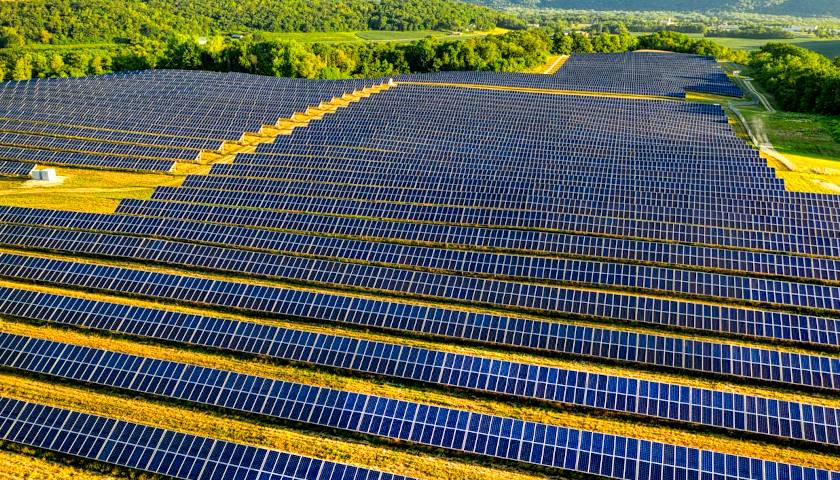by Edward Ring
The justification for rapidly transitioning the global energy economy to renewables is to avert a catastrophic environmental crisis. It is based on the premise that anthropogenic greenhouse gas emissions, primarily from the combustion of coal, natural gas, and oil, are altering our atmosphere, which in turn is leading to a host of negative consequences too numerous to mention.
It is possible nowadays to find almost anything, from crime and disease and mental health to species extinctions, deforestation and disappearing coral reefs, being attributed to climate change. And if you research almost anything involving the design of civilization, not just the production and consumption of energy but housing, mining, ranching, farming, shipping, transportation, waste management, water treatment, etc., the data most prominently reported are always carbon and CO2. The actual units of energy or water, or tonnage of product, or any other practical data necessary to inform management and logistics, has now become secondary. It’s all about carbon.
This may or may not be a compelling and appropriate redirection of our intellectual resources, but it is a distraction from what remains necessary, which is cutting through the avalanche of carbon data to get at how much energy we use and how much energy we need. And while some revanchist holdouts actually still believe atmospheric CO2 is not an existential threat, but in fact is an existential necessity, and are still willing to engage in debate over what they still view as an open question, there is no debate, anywhere, over the fact that we need adequate energy supplies if we are to continue to have a civilization. The only debate in that regard is how much energy do we need.
To that end, there are two encouraging avenues towards a consensus on energy strategy. The first is to agree on energy solutions that adequately address climate change concerns but make economic sense anyway. The second, which follows from the first, is to identify emerging technologies that will maximize energy efficiency. Anytime there is a cost-effective way to get the same energy service from less raw fuel input, the more efficient solution has an economic advantage. And this is where there are compelling arguments for electrification.
The Case for Electrification
The best way to illustrate why using electricity wherever possible can be a universally preferable energy solution is based on how much energy is lost using combustion-based solutions. In the United States, based on statistics from the Energy Information Administration, when using coal, oil and natural gas, 2/3rds of the raw energy input is lost to heat, friction, and exhaust. Examples of this are found in the most widely relied-upon applications. A coal or natural gas fired power plant still only averages 33 percent efficiency. A gasoline fueled vehicle typically only converts about 25 percent of the energy embodied in a gallon of gas into traction to move it down the road.
With electricity, these ratios are often flipped. Electricity generated by solar or wind energy goes directly into the transmission lines, where, just as with any electricity generator, about 5 percent is lost between the the source and the end user. Unlike coal and natural gas, solar and wind power is intermittent and requires battery storage, but in that round-trip cycle of charging and discharging, the electricity going back out still retains 80 percent of the electricity that went in.
These are clear advantages. They suggest that by electrifying major sectors of the economy, including most transportation and residential applications of energy, it would be possible to enjoy the same level of energy services while only expending half as much raw energy input. But there are also big challenges to electrification.
With respect to producing electricity, there is the need to occupy massive amounts of space for wind and solar farms. In the case of solar farms, they have to be overbuilt in order to still deliver adequate power during the short days of winter. Wind turbines, which require even more space than solar, would have to sprawl over thousands of miles, including offshore areas. They are decentralized sources of power, which means they require huge investments in distribution systems. They deliver intermittent power and require battery storage facilities.
There are also not-so-obvious problems with electrification—specifically, the so-called embodied energy in these solar panels, wind turbines, and batteries. It takes a tremendous amount of energy to make them, transport them, and install them, and yet they only have a useful life of 20-30 years. This energy debt has to be paid back before these technologies can be counted as renewable. They also consume far more resources in their manufacture than conventional energy generators, and they are expensive to recycle.
These concerns, however, are not an argument against electrification; they are only about how to generate electricity. For example, if nuclear power were supplying more electricity to the grid, there would be no need for excessive new transmission lines or battery farms, and nuclear power plants can last 60 years or longer.
On the end-user side, there are also problems with electrification. EV batteries are expensive and use a lot of resources. They are so heavy that EVs are causing unanticipated wear on roadways and far more pollution from tire fragments. And, of course, they take too long to charge. When it comes to residential electrification, heat pumps are an efficient solution in warmer climates, but they won’t work in a Minnesota winter. Heat pumps operate by extracting heat from one place—outdoors—then concentrating it, because it may be cold outside, to transfer it into your home. That’s fine in California in January, when it’s a bitter 48 degrees outside. But there simply isn’t enough heat in the air when it’s 20 below zero outside. The colder it gets outdoors, the more a heat pump has to work.
The Case for Fossil Fuels
There is an immutable reality confronting proponents of renewables, which is that fossil fuel still provide 80 percent of global energy. This reality is compounded by two additional facts. First, the most favored renewables, wind and solar, only account for 7 percent of global energy production; the rest, in roughly equal proportions, are big hydroelectric turbines and nuclear power stations. Second, for everyone on earth to consume just half as much energy as Americans do, global energy production would have to double.
To reference units that energy economists rely on, according to the Energy Institute’s Statistical Review of Global Energy, in 2022 total raw energy inputs worldwide were just over 600 exajoules. Taking into account a projected global population of 10 billion people by 2050 and a per capita energy input of 100 gigajoules (about one-third of the current U.S. per capita energy input), global energy production must rise to 1,000 exajoules in just 28 years. To do that purely with wind and solar sources of energy would require a 25X increase from the amount of installed base today. Even if there were space enough to do this, the resource consumption would make today’s global mining impact trivial by comparison. And based on a 20-30 year service life for wind and solar installations, by the time it was completed, you would have to start all over again.
Adding to these cautionary facts is the rising awareness, alluded to already, that renewables aren’t always renewable. The most egregious example of this may be biofuel plantations around the world, which already consume approximately 500,000 square miles in exchange for only displacing 2 percent of oil production. For all practical purposes, biofuel is fully built out. And as previously noted, there is significant negative environmental impact from most renewables, certainly including current biofuel, battery, solar, and wind technology.
The good news is there is enough fossil fuel to supply, just based on proven reserves, 500 exajoules of power per year for another 100 years. Taking into account estimated undiscovered reserves (including Abiotic oil) in the United States onshore and offshore and in the rest of the world is likely to double that estimate. That allows plenty of time to research and develop alternative sources of energy, but without fossil fuel providing at least half of our energy, delivering adequate energy to everyone on earth, i.e., achieving a minimum worldwide total of 1,000 exajoules of energy per year, is probably impossible.
As we pursue breakthrough energy technologies such as advanced fission power and fusion, our ability to more efficiently harness fossil fuel continues to progress. Combined cycle natural gas power plants now achieve over 60 percent conversion efficiencies, and the latest designs (that use a heat exchanger that can harvest higher temperatures from the first turbine’s exhaust) promise to deliver even higher conversion efficiencies. Similarly, the latest hybrid automotive designs, using high-compression engines, regenerative braking, and innovative transmissions, have gasoline-to-traction conversion efficiencies approaching 50 percent.
Our Magnificent Future
This is just the beginning. An all-of-the-above energy development strategy means that no promising leads are excluded, and no technologies need be deployed before they’re ready. There are technologies emerging that can convert raw coal into clean burning natural gas or zero emission hydrogen. There are stationary battery solutions that use abundant and inexpensive iron, sulfur, and water and last longer than lithium-ion batteries. There are solid state batteries being developed for EVs and hybrids that have higher energy density, can tolerate more cycles before degrading, and can be charged in minutes.
Looking further into the future reveals wondrous innovations that we can already imagine attaining feasibility. With abundant energy, we no longer have to be concerned about how much power is necessary to run desalination plants to turn millions of acre feet of ocean water into fresh water. With abundant energy, we can electrolyze hydrogen from water, extract CO2 from the atmosphere, and blend them into a liquid hydrocarbon fuel.
Most significant of all, of course, is the impact abundant energy will have on the quality of life for everyone on earth. Abundant energy is, by definition, almost always affordable energy. And a global energy grid that offers an inclusive assortment of energy options—renewables, nuclear, and fossil fuels—is also a resilient grid, able to withstand disruptions because multiple alternative sources of energy are always present.
By adopting an inclusive, all-of-the-above energy strategy, sustainable abundance in all things is possible because energy is the foundation of general economic growth. Hence, delivering affordable energy translates into everything becoming more affordable, and that, ultimately, is the prerequisite for global equity among peoples and nations. By encouraging energy development on all fronts simultaneously, humanity can eliminate energy poverty, which is one of the most problematic obstacles to peace and prosperity. In so doing, we shall make all other challenges, daunting though they may be, a little bit easier to overcome.
– – –
Edward Ring is a senior fellow of the Center for American Greatness. He is also the director of water and energy policy for the California Policy Center, which he co-founded in 2013 and served as its first president. Ring is the author of Fixing California: Abundance, Pragmatism, Optimism (2021) and The Abundance Choice: Our Fight for More Water in California (2022).
Photo “Solar Farm” by Tom Fisk.




